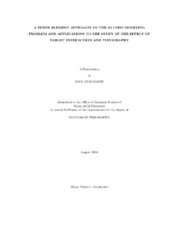| dc.description.abstract | The solution of the secondary coupled-vector potential formulation of Maxwell??s equations governing the controlled-source electromagnetic (CSEM) response of an arbitrary, threedimensionalconductivitymodelmust be calculatednumerically.The finite elementmethod is attractive, because it allows the model to be discretized into an unstructured mesh, permitting the specification of realistic irregular conductor geometries, and permitting the mesh to be refined locally, where finer resolution is needed. The calculated results for a series ofsimple test problems, ranging from one-dimensionalscalar differentialequations to three-dimensional coupled vector equations match the known analytic solutions well, with error values several orders of magnitude smaller than the calculated values. The electromagnetic fields of a fully three-dimensional CSEM model, recovered from the potentials using the moving least squares interpolation numerical differentiation algorithm, compares well with published numerical modeling results, particularly when local refinement is applied. Multiple buried conductors in a conductive host interact via mutual induction and current flow through the host due to the dissipation of charge accumulated on the conductor boundary. The effect of this interaction varies with host conductivity, transmitter frequency, and conductor geometry, orientation, and conductivity. For three test models containingtwo highly conductive plate-like targets, oriented in various geometries (parallel, perpendicular, and horizontal), mutual coupling ranges as high as twenty times the total magnetic field. The effect of varying host conductivity is significant, especially at high frequencies. Numerical modeling also shows that the vorticity of the currents density induced in a vertically oriented plate-like conductor rotates from vertical at high frequencies, to horizontal at low frequencies, a phenomenon confirmed by comparison with time domain field data collected in Brazos County, Texas. Furthermore, the effect of the presence of a simple horst on the CSEM response of a homogeneous conductive earth is significant, even when the height of the horst is only a fraction of the skin depth of the model. When the transmitter is placedon topofthe horst, the currents inducedtherein account for nearly all of the total magnetic field of the model, indicating that topography, like mutual coupling must be accounted for when interpreting CSEM data. | en |


